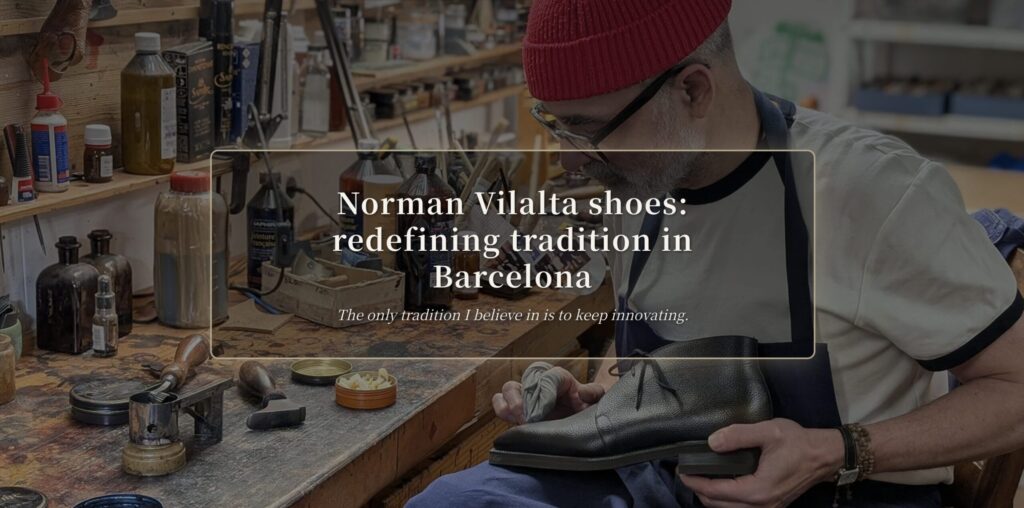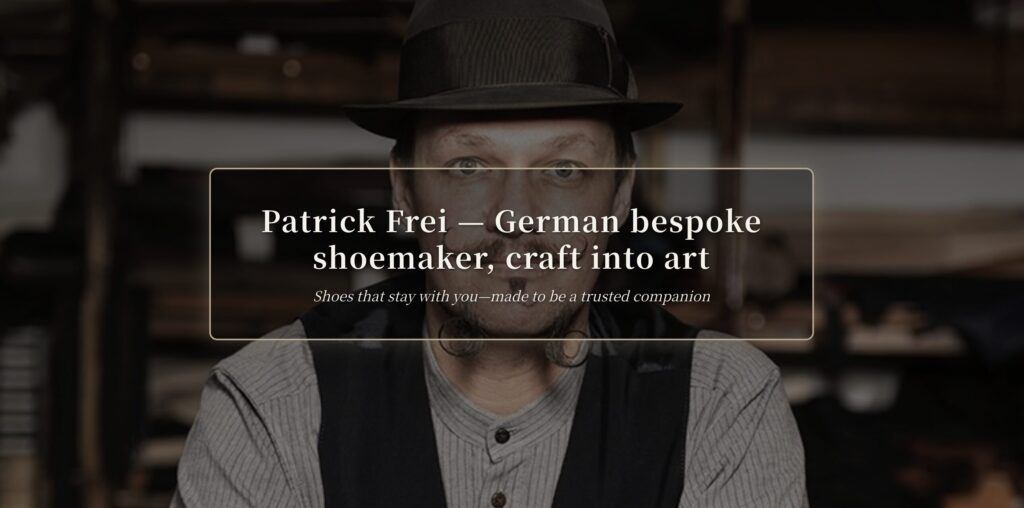Florentine Marquetry: A Story of Tradition and Innovation
Published: /Last updated: /Author: Masayuki Kaneko
Photos are used with permission; the text has been reviewed by the interviewee.
Walk the cobblestones of San Frediano in Florence’s Oltrarno and you’ll find a small studio at Via dei Cardatori 20r. This is ZOUGANISTA, the marquetry (wood inlay) workshop run by Takafumi Mochizuki — today one of the very few specialists in the city. When he opened in 2014, there were no artisans in Florence making a living solely from marquetry. In this article we examine his practice through the “5C” lens — Craft, Comfort, Care, Cost, and Continuity — to understand how Florentine marquetry endures and evolves in his hands. The name “Zouganista” combines zougan (Japanese for inlay) with the Italian suffix -ista, and his motto “Born in Tokyo. Made in Florence.” captures a mindset of creating new objects with skills forged between two cultures.
Video: Sand shading to add depth in marquetry (Zouganista official YouTube)
Choosing to Guard a Fading Tradition in Florence

In 2013, when Mochizuki obtained a self-employment visa and registered his business, Florence had no artisans dedicated solely to wood inlay. A few veteran furniture restorers still knew the technique, but nobody relied on marquetry work as a profession. This mirrors many historic cities worldwide. Drawing on skills learned from maestro Renato Olivastro and market sense from his sales career, he launched independently. His hypothesis was simple: apply traditional techniques to contemporary objects and demand would follow. On the first Saturday after opening, a passerby commissioned a logo inlay for a cigarette case — the first proof that his bet could work. Scarcity itself, paradoxically, became an advantage; the rarity of the technique created value and supported continuity.
From Salesman to Artisan — A Life Changed by a Fret Saw

Born in Tokyo in 1979, Mochizuki studied business administration, then interior design, and worked in furniture sales. In 2007 he moved to Florence; in 2008 he began studying antique furniture restoration under Olivastro. The first time he held a marquetry fret saw, he recalls, “it simply clicked.” Cutting stacked veneers 0.7–0.8 mm thick into millimeter-scale parts can take a week per piece and demands intense focus. Sales experience informs his workshop decisions; craftsmanship guarantees quality — a combination that defines his identity.
0.7 mm Veneers and Pre-Electric-Age Techniques
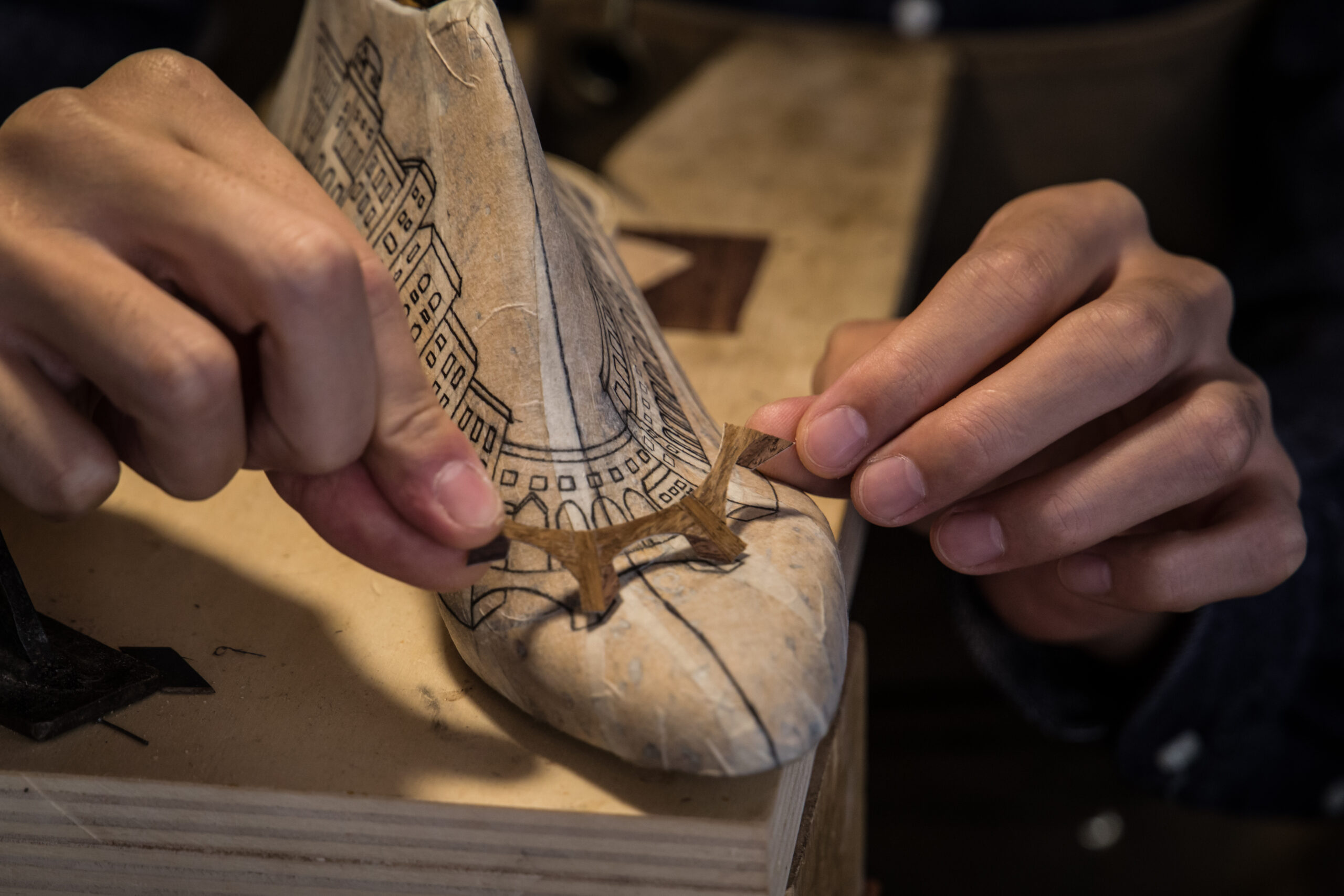
Mochizuki’s method preserves the essence of an era “before electricity.” He stacks five sheets of 0.7–0.8 mm veneer and cuts by fret saw. Species span rosewood, curly maple, birch, walnut, mahogany, ebony, wenge, purpleheart, oak, pommele and more. He uses hide glue (colla di bue) and finishes with shellac/French polish. These choices mirror 18th-century practice and avoid reliance on power tools or synthetic adhesives. Traditional processes also aid durability and repair: hide glue can be reactivated with moisture and heat, and shellac can be renewed by polishing and re-coating. Failures lurk, however — fragile veneers can crack during cutting, and mismanaging glue temperature weakens bonds — so he constantly tunes process to humidity and temperature.
Designing Contrast When Wood Colors Are Limited
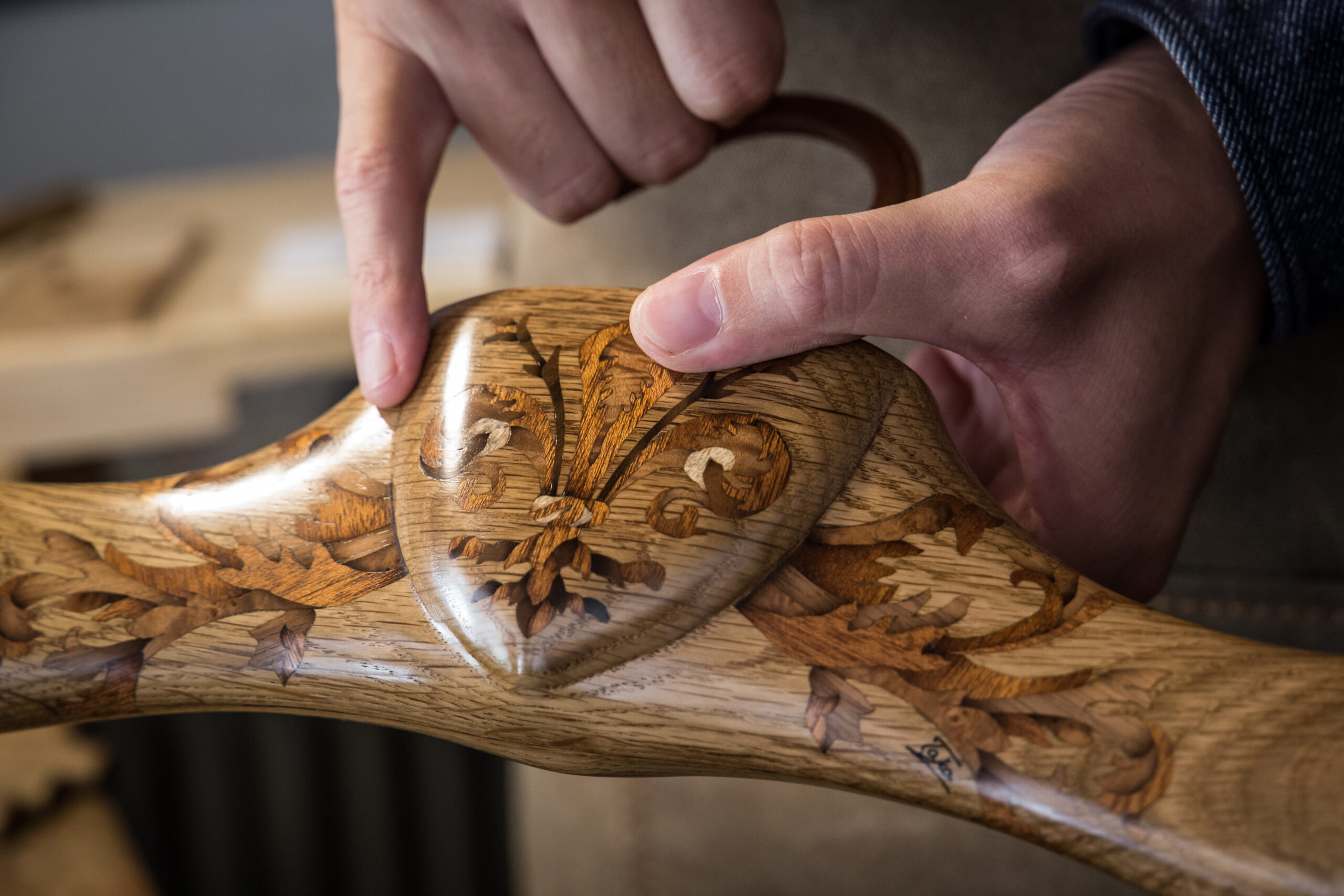
The hardest part of marquetry isn’t cutting — it’s contrast. With a limited palette of wood tones, he combines flat-sawn/quarter-sawn/burl orientation and the way light hits the grain to maximize visual depth. In his “Panorama Firenze,” for example, twelve woods render the cityscape; shadows and sky arise purely from grain direction and selection. High-contrast pairs like curly maple vs. ebony are straightforward; mid-tones like walnut vs. mahogany demand subtle handling and experience — a preference that raises time and price for nuanced work.
Sand Shading & Hide Glue — Florentine Finishing Methods
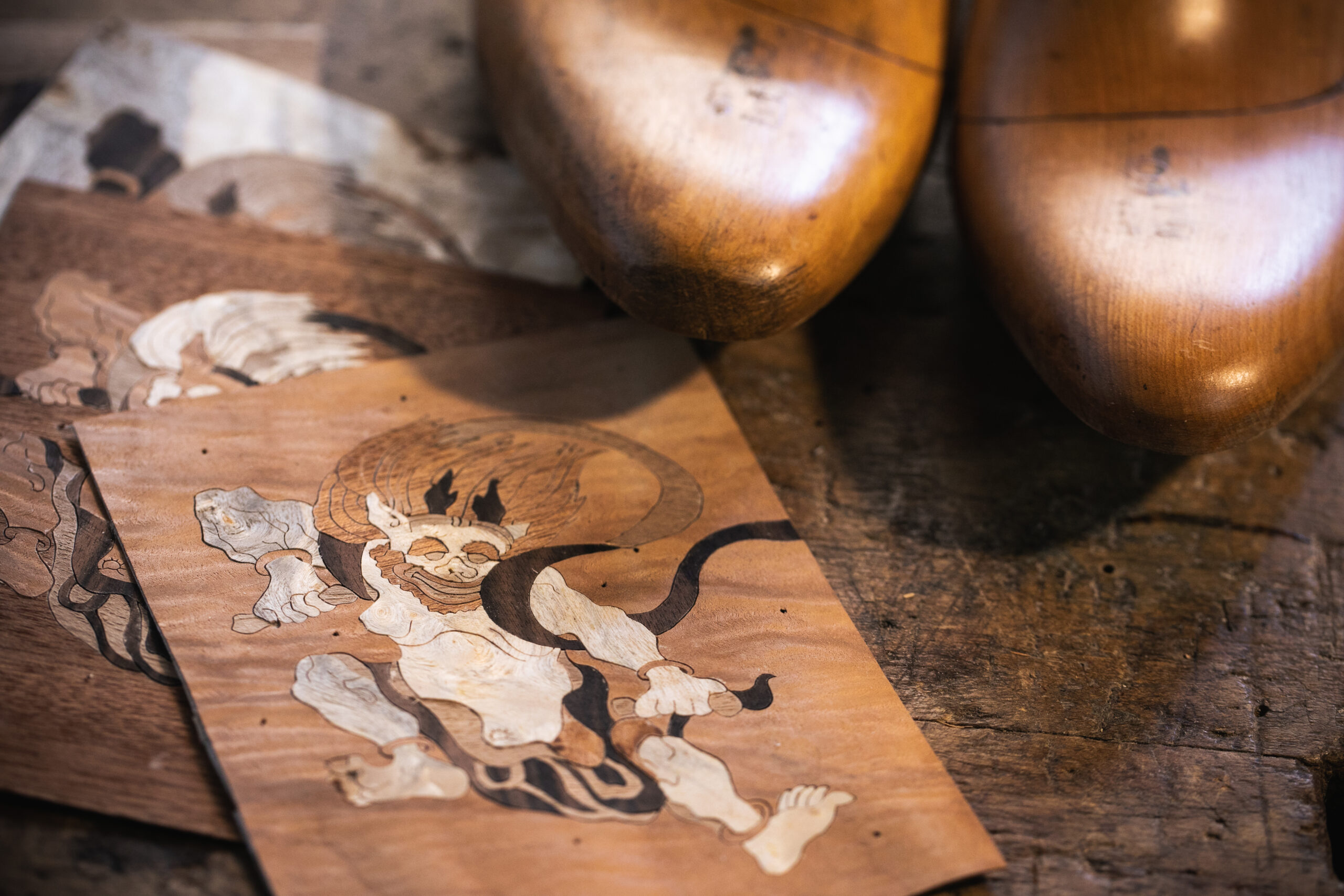
Florence’s traditional sand shading gives marquetry its shadows by pressing wood into heated sand — no chemical dyes needed — preserving the wood’s feel and aging gracefully. Sand temperature control is critical: too hot and fibers char; too cool and tones fall flat. Hide glue sits at the core: warmed it flows, cooled it sets, and it remains reversible for future repairs — unlike most modern adhesives. This choice underlines his commitment to repairability and long-term continuity.
Brass Lines & Kintsugi Motifs — Japan Meets Italy

Mochizuki often accents wood with brass lines, inspired by the philosophy of kintsugi — elevating cracks and voids into beauty. In a cabinet for Tie Your Tie Florence, a brass logo inlay adds a glow wood alone cannot. Brass also serves function: placed on edges of card cases or coin trays, it resists wear. Oxidation over time is discussed with clients in advance, along with care methods — an approach that builds trust and eases maintenance. One signature piece sets Japan’s wind and thunder deities on 18th-century Italian walnut; wormholes studded with brass read like stars across a night sky — a dialogue across time and place.
From Shoe Lasts to Watch Cases — Marquetry on Curves
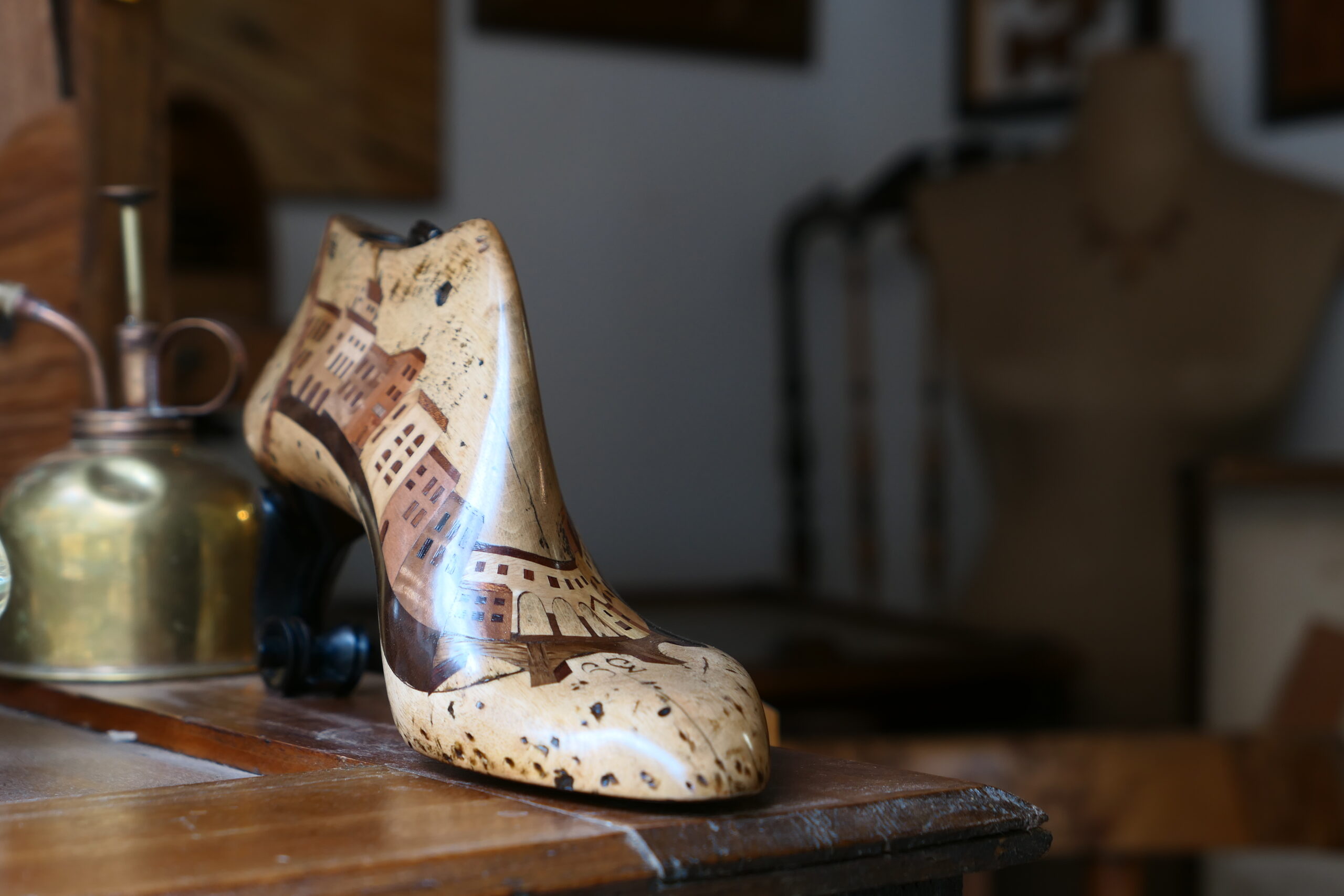
Traditional marquetry lives on flat panels, yet Mochizuki actively pursues curves. “Carnevale,” a shoe last inlaid with a carnival mask, requires humidifying veneer and bonding in stages to follow complex forms. He applies similar thinking to hat blocks, lampshades, even skateboards and watch cases. Function remains intact: a watch box lid must open cleanly, a skateboard’s foot area must retain grip. This balance of use and beauty is why global menswear aficionados notice his work.
A €3,500 Watch Case — How Price Relates to Value
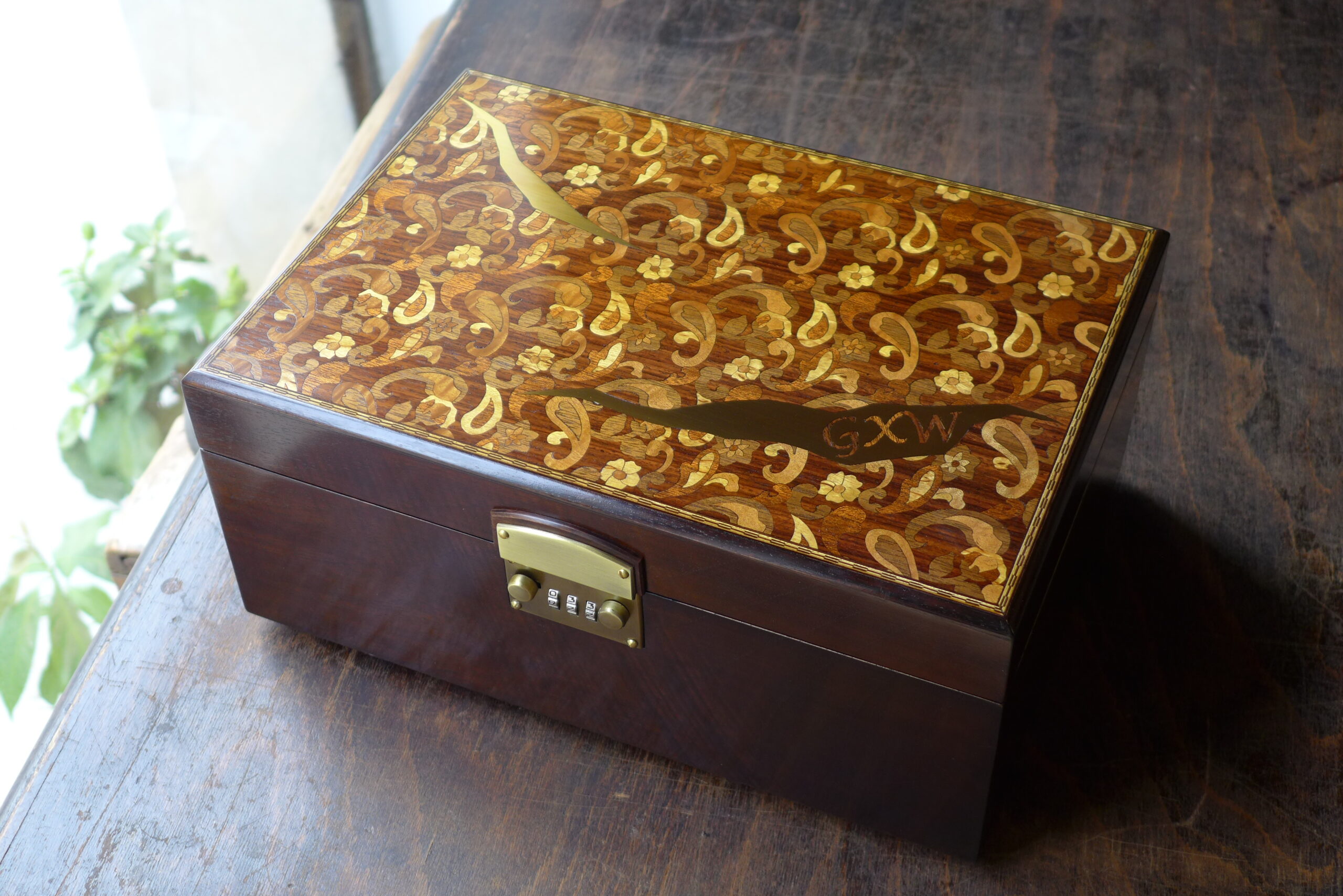
When George Wang of Brio Beijing ordered a watch case, the price was €3,500 (約55万円). Compared with smaller items — pendants around €80 or coin cases around €300 — it sits in another category. Yet the price aligns with labor: a week just to cut stacked 0.7–0.8 mm veneers, followed by curved bonding, sand shading, and shellac finishing — three to four weeks in total. Smaller goods finish faster and suit first-time buyers; complex pieces reward connoisseurs. Maintenance is simple: dust with a dry cloth and apply beeswax or mink oil once or twice a year. Thanks to reversible hide glue, repairs can restore the original state — a strong long-term value case.
Currency conversion not applied.
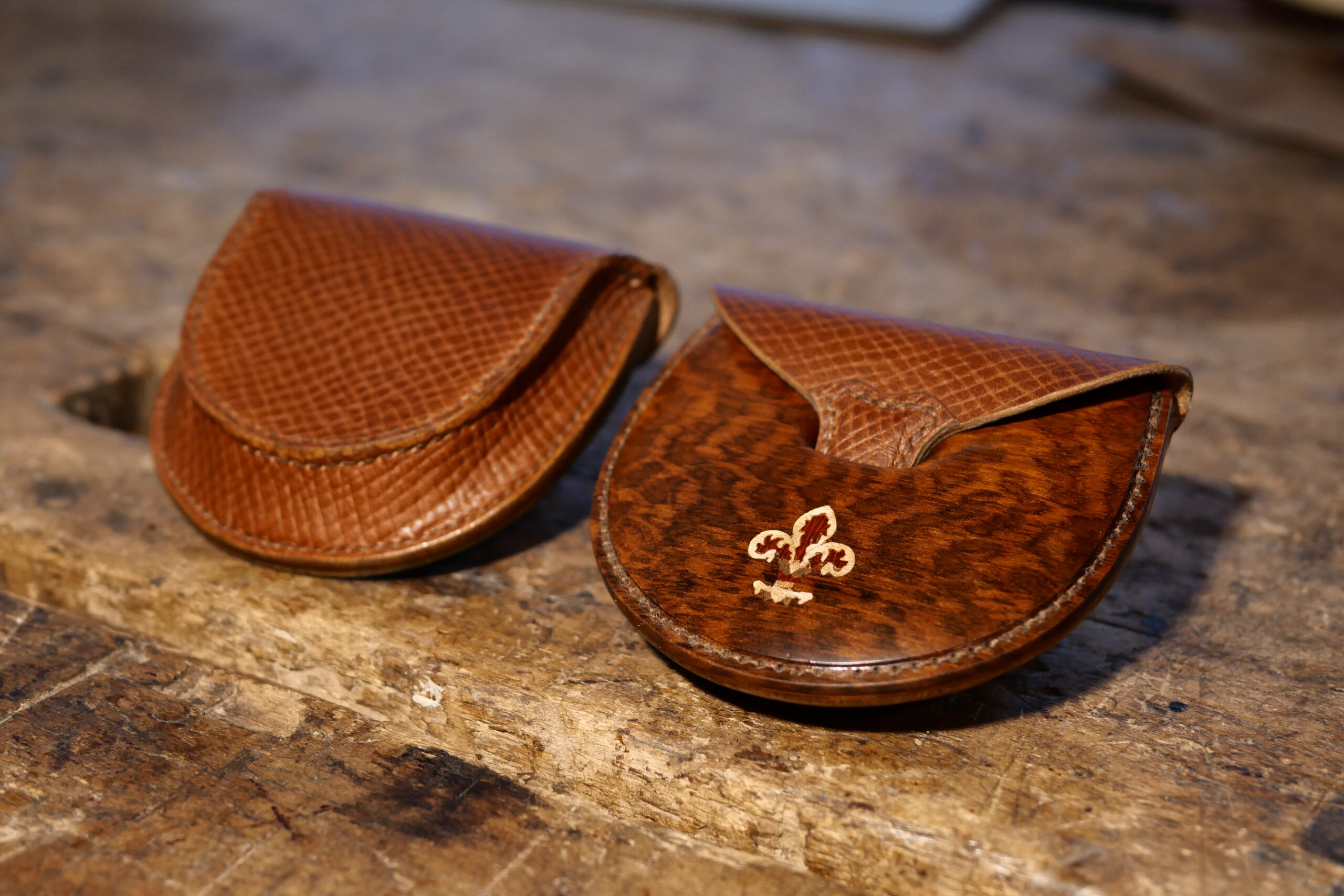
A Workshop as Cultural Heritage — Materials Since the 17th Century
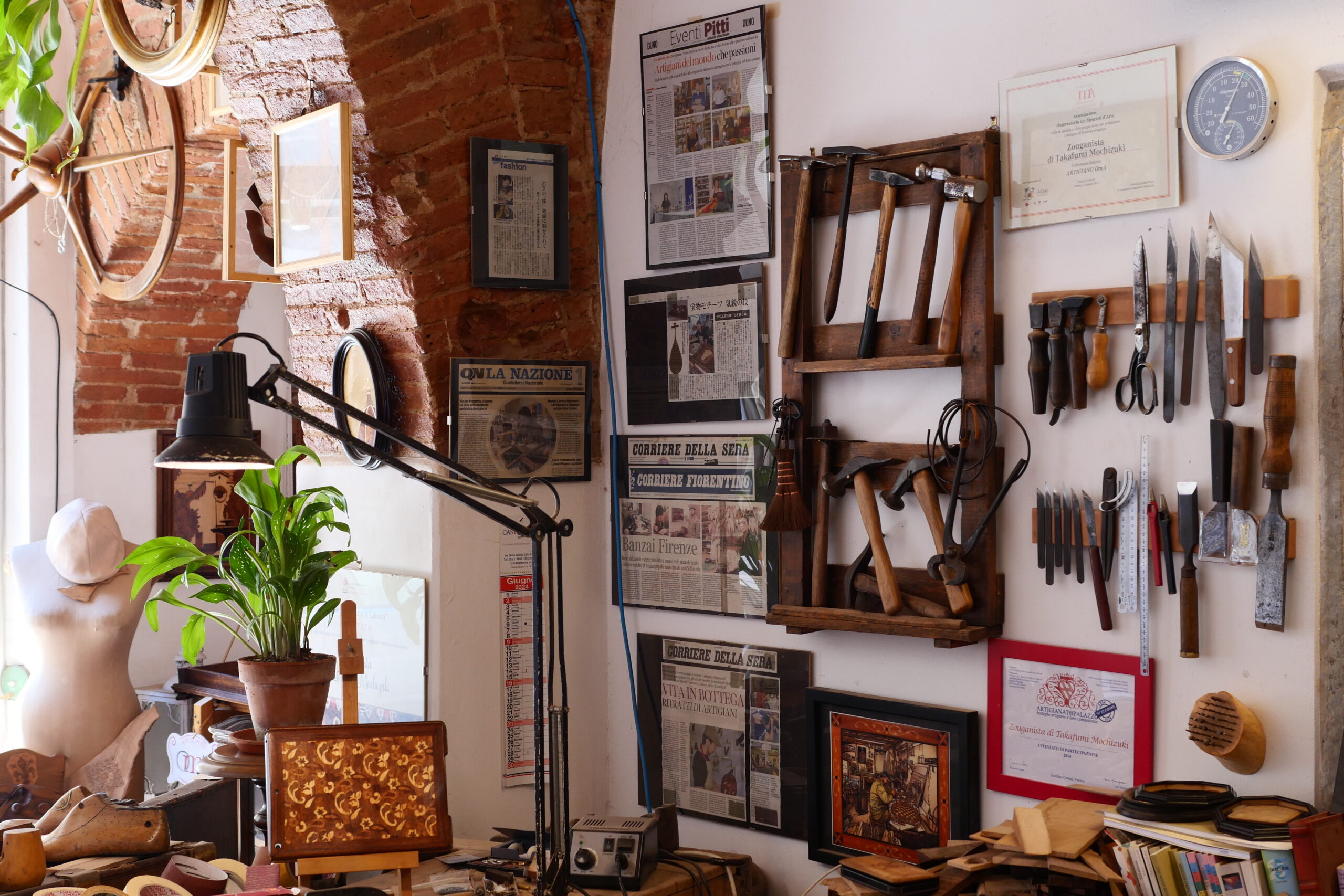
In Italy, workshops often outlive families because materials matter. To repair a 17th-century cabinet, you need period-appropriate veneer and hardware. Eleven years on, Mochizuki’s shelves now hold veneers, fittings, hide glue and pigments spanning eras — raising the workshop’s value and ensuring better future restorations. Location also supports continuity: after viewing 20–30 candidates he chose Via dei Cardatori 20r — a walk from the Duomo and Ponte Vecchio, reasonably priced, and large enough to store stock safely.
A Year of Silence — Overcoming Bias as an Asian Artisan

Beginning in 2008, Mochizuki faced a year when greetings went unanswered — a sobering introduction to the role of connections and lingering bias. Yet the rarity of the skill also attracted allies. Listings on FeelFlorence and the Michelangelo Foundation’s Homo Faber Guide acknowledged his craft publicly, and in 2015 AD Italia named him among “20 Creatives Under 40.” The lesson: technique carries value beyond nationality; when artisans are scarce, dedication resonates.
Airbnb Experience — Conveying Marquetry in Two Hours
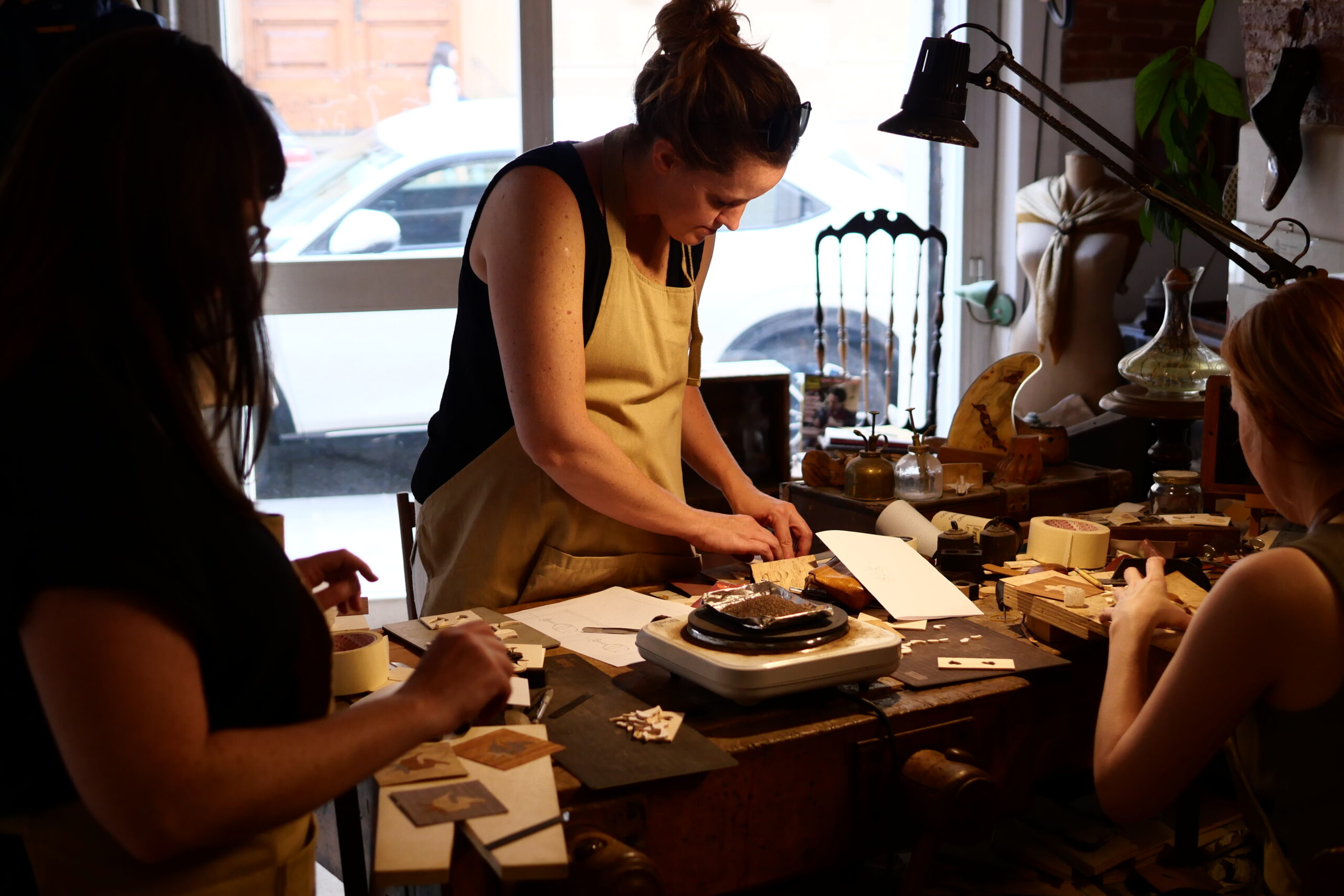
Through Airbnb Experiences he offers “Craft a wooden puzzle” — about two hours, up to four people, in Italian, English, or Japanese. The session covers history, veneer selection, cutting, assembly, sand shading, and finishing. Reviews average 5.0, and pricing is shown as 約¥13,140/人 depending on season and currency settings. Participants feel why precision matters: too much pressure cracks thin veneer, so he demonstrates force and lets guests practice on scraps; dampening veneer adds flexibility — a simple risk-reduction step. The class also spreads awareness: many attendees meet marquetry for the first time and later become clients.
Repairability & Supply — Why He Visited 20–30 Spaces
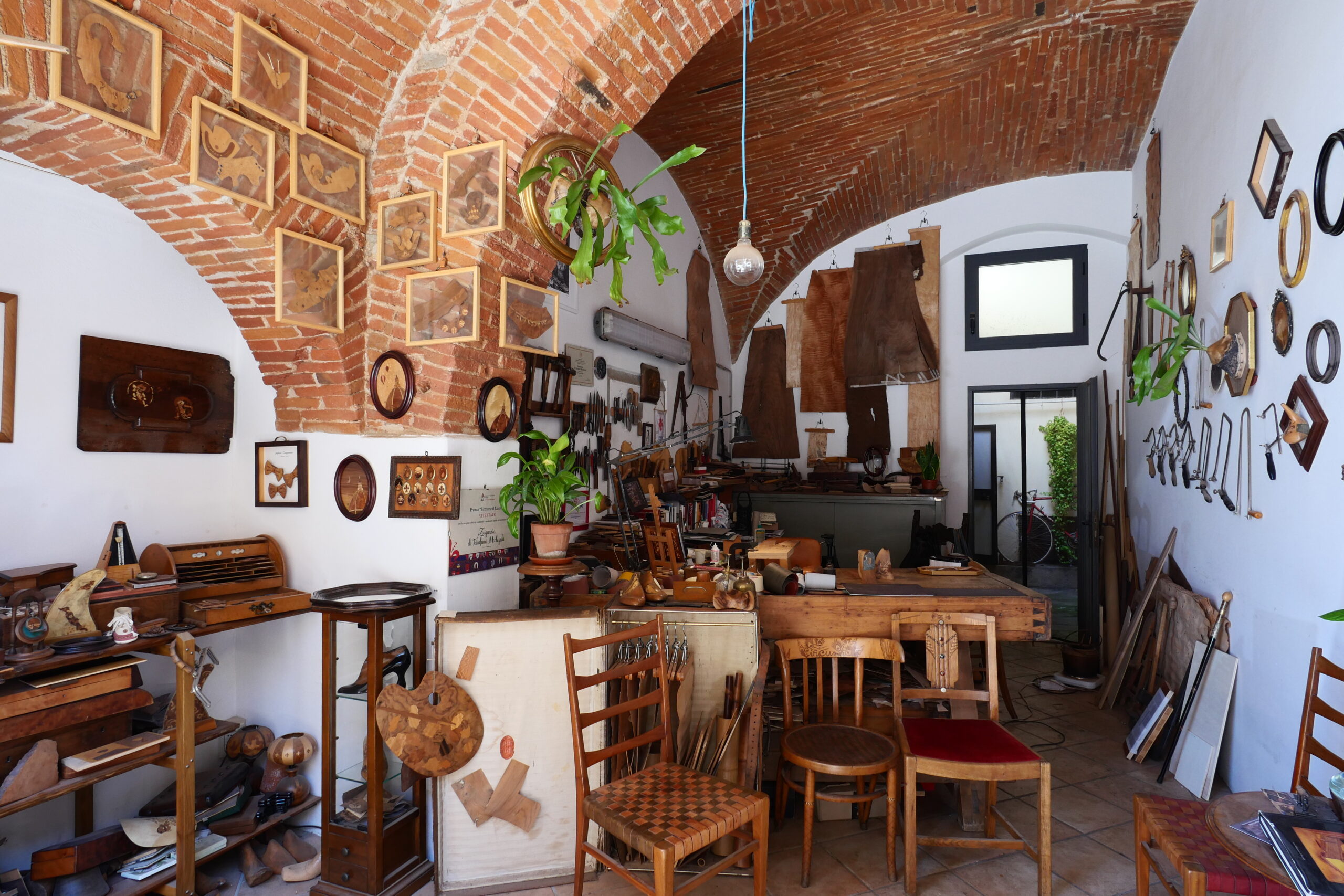
Ahead of opening in 2014 he toured 20–30 possible spaces. Requirements: storage with stable humidity/temperature; a site where noise and dust won’t trouble neighbors; and easy visitor access. The chosen spot near the Duomo and Ponte Vecchio meets all three. Continuity matters for repairs a decade or two later — studios close, but materials and records must remain. Financial prudence and diversified income help ensure the doors stay open.
Why AD Italia Chose “20 Creatives Under 40”

In 2015, AD Italia selected Mochizuki among “20 creators under 40 changing interiors,” recognizing not just preservation but innovation. He applies historic technique to everyday forms — shoe lasts, skateboards, watch cases — bringing marquetry out of museums and into life. As Vogue Italia noted, he unites Japanese precision with Italian creativity; Vanity Fair praised unique pieces enriched by inlays of mahogany, birch, and ebony. Locally, he’s seen as a maker who embodies “Made in Florence” and is urged to carry the city’s craft forward.
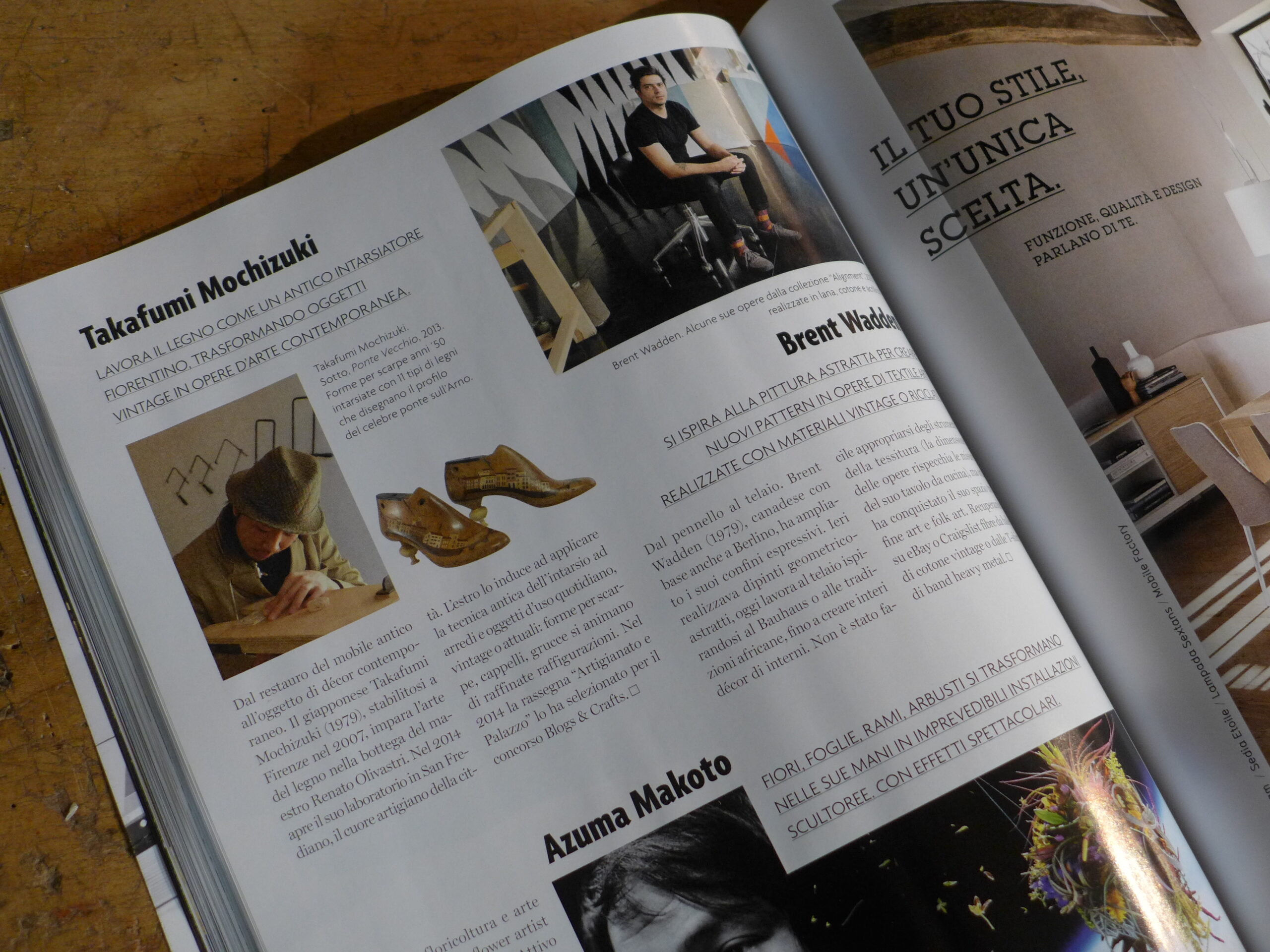
Summary
Viewed through the 5Cs, Mochizuki preserves the core of pre-electric marquetry — stacked thin veneers cut by fret saw, hide-glue bonding, sand shading, and shellac finishing — while pushing into modern objects like shoe lasts and watch cases. Brass inlay echoes kintsugi’s philosophy, fusing Japanese and Italian aesthetics. The workshop itself is a repository of materials that guarantees long-term repairability. His Airbnb class compresses the essence into two hours and seeds the next generation. Recognition by AD Italia attests to the global relevance of his approach. The question ahead is transmission: as one of the few specialists, how will he pass Florentine marquetry to future hands?
Workshop Info
ZOUGANISTA di Takafumi Mochizuki
Address: Via dei Cardatori 20r, 50124 Firenze, Italy
Tel: +39 331 822 3767
Email: mail@zouganista.com
Website: www.zouganista.com
Hours: 10:00–19:00 (contact in advance recommended)
Social / Online
YouTube: ZOUGANISTA / Artisan Training in Italy
Instagram: @zouganista
X (Twitter): @lunapienabytaka
Facebook: Zouganista
note: Memoir of Becoming an Artisan in Florence
Blog: Ameba Blog
Orders & Commissions
Accepting inquiries via Instagram DMs, other social channels, or email.
Works can also be purchased/commissioned at an annual exhibition held during his visit to Japan.
Workshop Experience
Airbnb Experience “Craft a wooden puzzle”
Duration: ~2 hours / Max 4 people / Languages: Italian, English, Japanese
Price: 約¥13,140 per person (varies by season)
Sponsorship Information
“The Makers Guild” is an international community site that shares craft and shoe culture. We are currently welcoming sponsorships from partners who support our mission.
